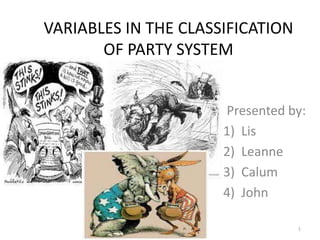
Comparative Political Representation
- 1. VARIABLES IN THE CLASSIFICATION OF PARTY SYSTEM Presented by: 1) Lis 2) Leanne 3) Calum 4) John 1
- 2. VARIABLES IN THE CLASSIFICATION OF PARTY SYSTEM 1) The Extent to which parties penetrate society 2) The Ideologies of the parties 3) The stance of the parties towards the legitimacy of the regime 4) The number of parties in the system 2
- 3. The Extent to which parties penetrate society 1) Venezuela and México have similar political systems 2) Are not usually considered similar political systems 3) The government of Nazi Germany was fascist, totalitarian regimes. 4) the government Of United States it is a constitution based Federal Republic; strong Democratic tradition Lis Davies 3
- 4. The Ideologies of the parties Klaus von Beyme has identifies nine party family ideologies: Liberal Radical or Socialist or Labour Communist Conservative Agrarian Regional or ethnic Christian Democratic Ecologist Extreme Right 4
- 5. Giovanni Sartori Italian political scientist Party systems classified by two dimensions fragmentation (the number of parties) The ideological distance between the parties, called polarisation
- 6. Moderate country •Two party or multi-party system the distribution of party power looks like a normal curve with a slight skew •Most of the country is moderate or moderate leaning liberal or conservative •Britain, Sweden and New Zealand
- 7. Polarized country •The curve becomes one with two main humps •Power is at the far political left and right •Weimar Republic in 1930s
- 8. Vicious circle of conceptualisation General theory to be constructed upon preliminary work of many profound studies but studies are only profound if there already exists a general theory.
- 9. Fragmentation and polarisation All systems defined by these two criteria according to the paradigm set by Sartori Polarisation determined by centrifugal/centripetal tendencies.
- 10. Most studies conducted in nations that conform to highest standards of relevance/influence such as sizable population, demographic diversity and remarkable properties Niche for new parties varies depending on low thresholds of representation (Sweden) versus higher ones (UK)
- 11. New Labour is a good example of centripetal activity Never before in history had the general public felt that there was so little to choose between. 1997-2005 Between 1987 and 1999 parties converge by 50 percent according to public opinion.
- 12. Disinterest discourages fragmentation From 1980 to 2000 Norway and the UK lose half of parties’ members with Germany sustaining a 30 percent loss despite unification and Poland recording a meagre one percentage point of the population engaged as a party member.
- 13. One/Two Party System One party system need simply be one where a single party has a monopoly on any realistic hope of being included in government. Two party system is defined as one where no party has the potential to interfere, disrupt or prevent the two major parties from governing independently
- 14. UK as a multiparty system (>2 parties) In addition to Liberal Democrat influence on Labour and Conservative chances of victory, regional parties in Scotland, Wales and Northern Ireland further fragment the major parties.
- 15. Party System Volatility Polarisation a sign of a healthy democracy but also heralds systematic instability
- 16. Low fragmentation with high polarisation British political spectrum of Labour versus Tories pre New Labour
- 17. High fragmentation with high polarisation Belgian governmental crisis of regional differences
- 18. Katz’s and Mair’s cartel party thesis Parties run by administrations with little concern for legitimately representing voters and just to collaborate with other major parties to preclude the development of new threats to their sphere of influence.
